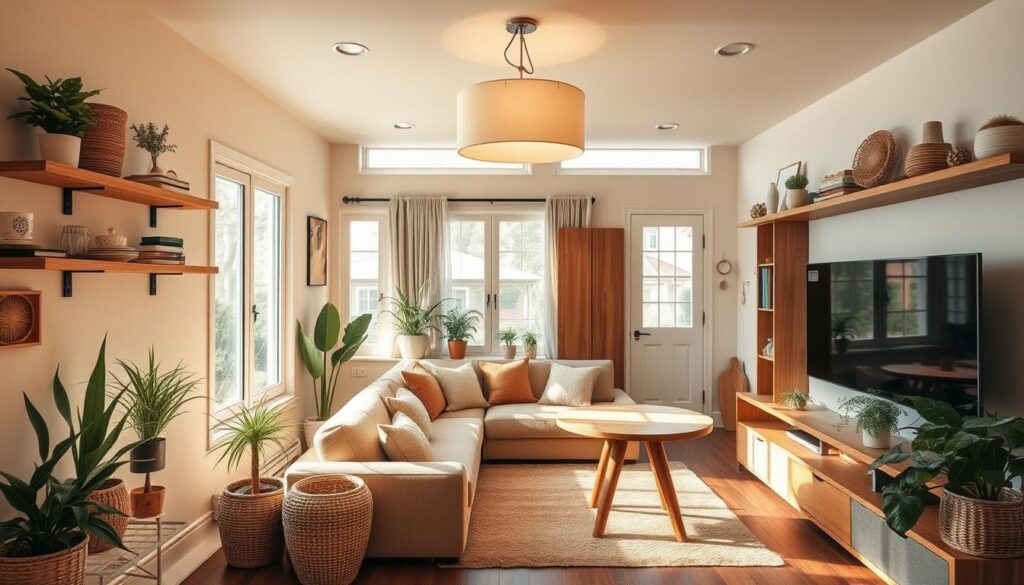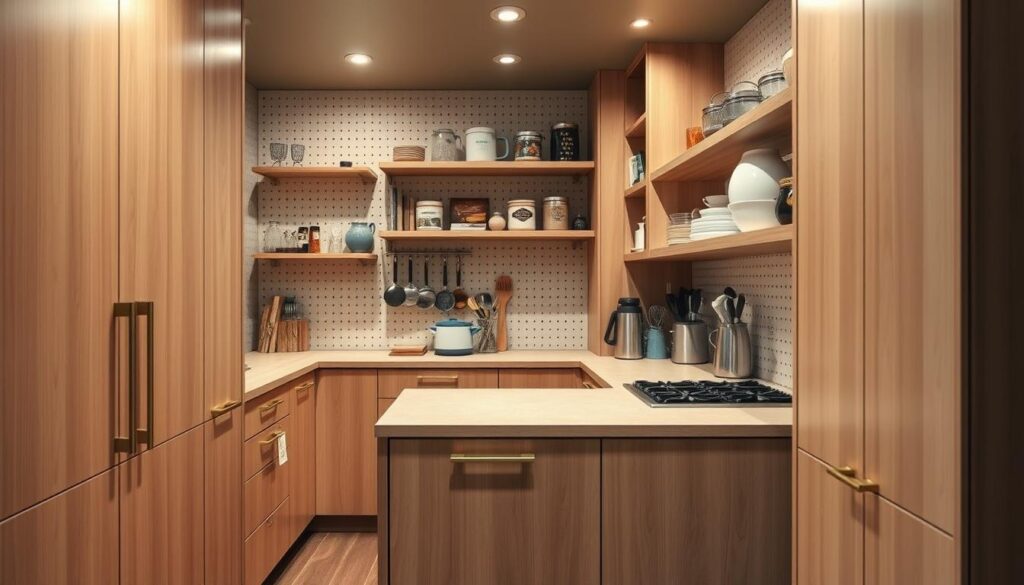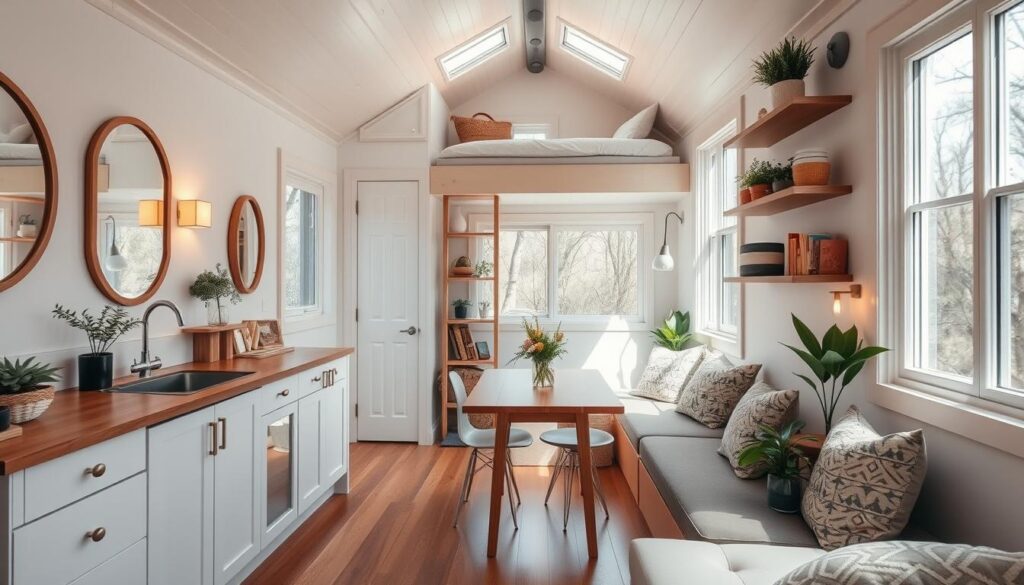Did you know that the average tiny home is about 400 square feet? Yet, it can feel spacious and luxurious.
Creating a cozy and functional space in a small area needs creativity and practicality. We look at small space design tips to make tiny homes feel welcoming. By using effective decorating tips, you can make your home feel open and flowing.
With the right minimalist home decor and layout, even tiny spaces can be stylish and comfortable. We’ll share our best tips for making the most of your small living area.
Key Takeaways
- Utilize wall-mounted furniture to free up floor space.
- Opt for multi-functional furniture pieces.
- Select a limited color palette to reduce visual clutter.
- Maximize natural light through strategic furniture placement.
- Consider unconventional layouts for better space usage.
Understanding the Concept of Tiny Living
Tiny homes are changing how we see living spaces. They promote a simple lifestyle that’s good for the planet and saves money. Let’s dive into what tiny living is all about and clear up some common myths.
Benefits of Living in a Tiny Home
Living in a tiny home has many perks. It can save you money and help the environment. Here are some of the main benefits:
- Affordability: Tiny homes cost less than regular houses, making it easier to own a home.
- Sustainability: They use fewer resources to build and maintain, helping the planet.
- Simplified Living: Tiny homes encourage a simple lifestyle, reducing clutter and making life more efficient.
For more tips on making the most of tiny spaces, check out our tiny home interior tips page.
Common Misconceptions About Tiny Homes
Even though tiny homes are becoming more popular, there are still many myths around them. Here are a few:
- Lack of Space: Tiny homes may be small, but they can be designed to use space well. They often have multi-functional furniture and smart storage.
- Limited Decorating Options: Actually, tiny homes offer a great chance to get creative. You can make your space unique with tiny house decorating ideas.
Design Principles for Tiny Spaces
Creating a tiny home that looks good and works well is a challenge. It’s key to find a balance between looks and function. This way, your tiny home can feel cozy and inviting.
Functionality vs. Aesthetics
In tiny homes, every piece must have a purpose. Space-saving furniture is vital for keeping things tidy while still being useful. But, looks shouldn’t suffer. Adding cozy small home interiors touches, like soft lighting and comfy fabrics, can make your tiny home feel big and welcoming.
To find this balance, think about pieces that do more than one thing. For example, a storage ottoman or a coffee table with hidden storage. These items add to the space’s look while also offering extra storage.
| Design Element | Functionality | Aesthetics |
|---|---|---|
| Space-saving furniture | Maximizes space | Variety of styles available |
| Multi-functional pieces | Provides additional storage | Enhances overall decor |
| Natural Light | Makes space feel larger | Improves ambiance |
The Importance of Natural Light
Big windows, skylights, and mirrors help bounce light around, making the space seem larger.
Light also makes your tiny home feel warmer and cozier. It showcases your decor’s best features and adds a sense of comfort.
To get the most out of natural light, try these tips:
- Use sheer curtains or blinds to let sunlight in.
- Place mirrors opposite windows to reflect light.
- Keep windows clear to let in as much sunlight as possible.
Choosing the Right Color Palette
The color palette you choose for your tiny home greatly impacts its feel and size. It’s key to pick colors that show your style and make the space feel bigger.
Light colors are a smart choice for tiny homes. Light colors on walls and ceilings make rooms seem bigger. This is great for tiny living rooms, where you want a clean and inviting space.
Light Colors to Enhance Space
Light colors on walls, floors, and ceilings make tiny homes feel roomier. White, cream, and pale gray are favorites for their ability to reflect light and make rooms appear larger.
- Soft whites and creams can make ceilings appear higher.
- Pale grays and blues add calm and make space feel bigger.
- Light wood tones and finishes also help make spaces feel more open.
Interior design experts say a monochromatic color scheme makes small spaces feel bigger. This method simplifies decor and creates a unified look that enhances space.
Accent Walls for Depth
Light colors are good for space, but accent walls add depth and character. An accent wall in a bold or contrasting color can draw the eye and distract from the room’s small size.
When picking an accent wall color, think about the look you want. For a minimalist style, a subtle contrast works well. A bold color adds a dramatic touch.
“Accent walls are a great way to introduce personality into a room without overwhelming the space.” – Interior Design Expert
By mixing light colors with accent walls, you can make your tiny home feel spacious and reflect your style.
Multi-Functional Furniture Solutions
In tiny homes, every piece of furniture is crucial. Multi-functional pieces help make the most of the space. The right furniture can turn your tiny home into a cozy and spacious living area.
Sofa Beds and Murphy Beds
Sofa beds and Murphy beds are essential in tiny homes. They offer both seating and sleeping areas. Sofa beds are great for living rooms that also serve as guest bedrooms. Murphy beds fold up against the wall, saving floor space during the day.
| Furniture Type | Primary Use | Secondary Use |
|---|---|---|
| Sofa Bed | Seating | Sleeping |
| Murphy Bed | Sleeping | Wall Storage/Space |
Foldable Tables and Chairs
Foldable tables and chairs are perfect for tiny homes. They can be tucked away when not needed, making room for other activities. Foldable tables work as dining or work areas. Foldable chairs provide seating or extra guest spots.
When picking multi-functional furniture, think about both function and style. Choose pieces that are useful and match your decor.
Clever Storage Solutions
In tiny homes, smart storage is crucial to make the most of every inch. It’s important to think outside the box when storing your stuff.
Using under-bed spaces is a great way to add storage. Under-bed storage can be done with beds that have drawers or special containers that fit under beds.
Under-Bed Storage Ideas
Under-bed storage is perfect for items you don’t use often, like winter clothes or extra blankets. To get the most out of this space, try using bed risers. They let you fit bigger bins under your bed.
- Use bed frames with built-in drawers for easy access.
- Invest in under-bed storage containers that can be labeled for easy identification.
- Consider using vacuum-sealed bags to store out-of-season clothing.
Vertical Space Utilization
Using your home’s vertical space is another smart move. Putting up shelves or storage units all the way to the ceiling can really help. It adds a lot of storage without taking up floor space.
To use vertical space well, try these ideas:
- Install floating shelves for displaying decorative items or storing books.
- Use stackable storage units for maximum flexibility.
- Invest in wall-mounted cabinets for additional storage.
By using these smart storage ideas, your tiny home can stay tidy and organized. This makes your home feel bigger and more comfortable.
Maximizing Vertical Space
Maximizing vertical space is key in tiny homes. It makes our living areas more organized, spacious, and cozy. We’ll look at how to do this with floating shelves and high cabinets.
Floating Shelves for Display
Floating shelves are great for storing and displaying items. They’re perfect for tiny homes where space is limited. They help keep things organized and make our homes feel more open.

- Put them at different heights for a cool look.
- Use them for decorations, books, or kitchen stuff.
- Keep them tidy to keep your space calm.
High Cabinets and Overhead Fixtures
High cabinets and overhead fixtures are also vital. They store items we don’t use often. This keeps our homes tidy and looks good too.
High cabinets and overhead fixtures offer many benefits:
| Feature | Benefit |
|---|---|
| Additional Storage | Keeps less frequently used items out of the way |
| Aesthetic Appeal | Contributes to a clean and organized look |
| Accessibility | Items are still within reach when needed |
By using these ideas, we can make our tiny homes feel bigger. It’s all about smart design and using every inch wisely.
Utilizing Mirrors to Create Illusion
Mirrors are a simple yet effective tool for creating the illusion of more space in tiny homes. They reflect light and images, making a room appear larger and more spacious. This technique is very useful in tiny living room decor, where space is a top priority.
How Mirrors Affect Perception of Space
Mirrors can change how we see the size of a room. When placed correctly, a mirror can make a room seem larger by reflecting its interior. This is true when mirrors are opposite windows, reflecting natural light and the outdoors, making the space feel bigger.
To get the most out of mirrors, it’s important to think about their placement. It’s not just about looks; it’s about creating depth. For example, a large mirror opposite a window reflects the view and brings the outdoors inside, blending the inside and outside spaces seamlessly.
Best Places to Hang Mirrors
When hanging mirrors in a tiny home, aim to maximize their reflective power. Here are some tips:
- Hang a mirror opposite a window to reflect natural light and the outdoors.
- Place a mirror above a sofa or fireplace to create the illusion of height.
- Use a large mirror on a wall to create the illusion of a larger space.
- Consider using multiple small mirrors in a collage to add visual interest and depth.
Adding mirrors to your minimalist home decor can greatly enhance the sense of space. By choosing the right size, shape, and placement, you can make your tiny home feel more spacious and welcoming.
Smart Kitchen Layout Ideas
Smart kitchen layouts are key in tiny homes. Every inch matters, and the kitchen must be functional. We aim to use space wisely without losing usability.
To do this, we can use compact appliances and open shelving. These strategies save space and improve the kitchen experience.
Compact Appliances That Save Space
Compact appliances change the game in tiny kitchens. They offer needed functions without using too much space. Here are some examples:
- Mini Refrigerators: Great for tiny homes, they store essentials without taking up much space.
- Compact Dishwashers: Designed for small spaces, they’re perfect for tiny kitchens.
- Two-Burner Stoves: These stoves cook well while fitting into tight spaces.

Open Shelving for Convenience
Open shelving boosts kitchen functionality in tiny homes. It adds storage and keeps essentials within reach.
Open shelving offers several benefits:
- Ease of Access: It lets you quickly grab dishes, cookware, and more.
- Visual Space: It makes the kitchen look bigger by keeping it open.
- Decorative Element: You can display decorative items, adding a personal touch.
By using compact appliances and open shelving, we can make tiny kitchens functional and stylish. It’s all about using space wisely.
Creating Cozy Bedroom Spaces
To make a cozy bedroom in a tiny home, think about both looks and function. A well-thought-out bedroom can really change how your home feels.
Creative Loft Bed Designs
Loft beds are great for tiny homes because they save floor space. Check out more tiny home bedroom to find the best loft bed for your cozy bedroom.
Some cool loft bed designs include:
- Loft beds with built-in storage
- Loft beds with desks or workspaces underneath
- Loft beds with curtains or dividers for privacy
Utilizing Nooks and Crannies
To use every bit of space in a tiny home, make the most of nooks and crannies. Use custom furniture or storage that fits these spots perfectly.
| Space-Saving Idea | Description | Benefit |
|---|---|---|
| Under-bed storage | Using bins or drawers under the bed | More storage for linens or out-of-season clothes |
| Wall-mounted shelves | Installing shelves on walls | Displaying items or storing books |
| Hidden compartments | Creating hidden storage in furniture | Keeping valuable or personal items safe |
By using these ideas, you can make a cozy and useful bedroom in your tiny home. It will feel big and relaxing.
Personalizing Tiny Home Interiors
Making your tiny home interior reflect your personality can enhance your living experience. It’s about creating a space that feels like home, despite its small size.
One of the most effective ways to personalize your tiny home is by incorporating personal art and decor. This can include family photos, artwork, or collectibles that tell a story or evoke a certain feeling.
Incorporating Personal Art and Decor
When choosing decor for your tiny home, it’s essential to strike a balance between aesthetics and functionality. Consider using multi-functional items that serve both purposes, such as decorative storage baskets or wall art that doubles as a shelf.
Plants for a Lively Feel
Adding plants to your tiny home can not only purify the air but also create a lively and welcoming atmosphere. Choose low-maintenance plants like succulents or air plants that thrive in indoor conditions.
By incorporating personal touches and plants, you can create a tiny home interior that is both beautiful and functional. It will reflect your personal style and preferences.
Tips for Maintaining a Clutter-Free Environment
Keeping a tiny home tidy is key, as space is tight. We must be careful with our stuff and make habits that help us stay organized. This way, we can follow effective tiny home interior ideas.
Effective Decluttering
Decluttering regularly is vital for a tidy tiny home. Set aside time each week to sort through your belongings. This practice is a big part of living small.
Organizing Hacks
Smart organizing tricks can greatly improve a tiny home. Using bins, baskets, and dividers helps keep things organized and hidden. This makes our living space look neat and tidy.
By using these tips, we can have a tidy and peaceful home in our tiny space. This makes the most of every inch we have.


